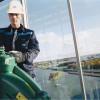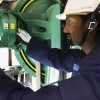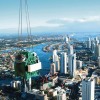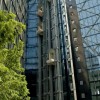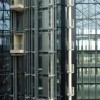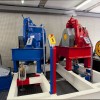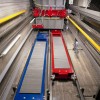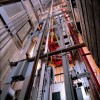Green Elevator Strategies
Video
alt=""Eco-friendly inventions now enable elevators to operate with much less energy, use less building square footage by eliminating traditional elevator utility rooms, and incorporate eco-sensitive finish materials. Likewise, green strategies for eco-modernizations are also available to renovate traditional elevators. Yet beyond new green technologies and renovations, an elevator itself is an important green tool.
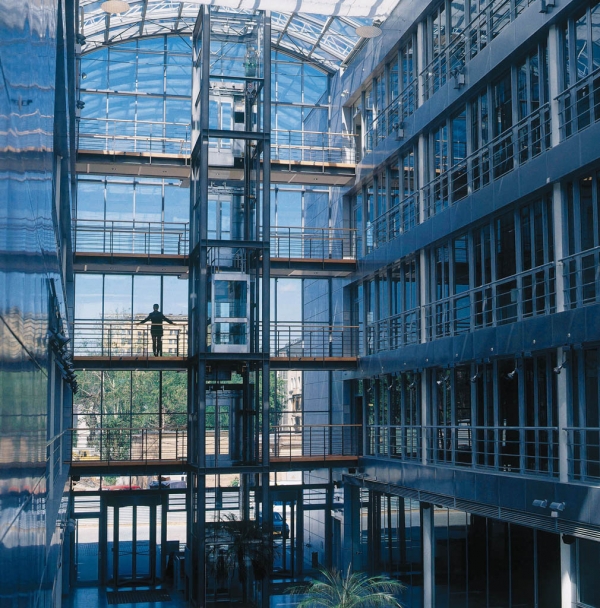 MRL Elevator
Photo Courtesy of KONE Elevators
MRL Elevator
Photo Courtesy of KONE Elevators
According to Bruce S. Fowle, FAIA, LEED, Senior Partner at FXFOWLE Architects in New York City, “Vertical transportation via elevators makes way for dense communities, which in turn conserves precious green fields from the depleting nature of a sprawling city.”
The invention of the elevator opened up the discovery of high rises and skyscrapers. Consequently, large vertical buildings with small footprints conserve the use of green fields, or land that has not yet been built upon. The more that humankind can preserve agricultural and natural territories, the healthier the overall ecosystem will remain. ”The Condé Nast (4 Times Square) building takes up only one acre of land in New York City. If it were constructed as a one or two-story building, it would consume up to 40 acres of agricultural fields,” said Fowle, designer of the 4 Times Square Building. Indeed, Manhattan is one of the greenest cities in the world because of its incredible density ratio of building mass to building footprint. It is no wonder that the first passenger elevator was installed by Otis in 1857 in Manhattan, New York City.
Eco-friendly options for new construction take on different forms and technologies, such as: innovative hoist machines, machine-room-less (MRL) designs, destination software, and sustainable materials. “Elevators use very little energy according to the overall amount within the building,” said Stuart Prior, Executive Vice President, Americas Product Sales and Marketing with ThyssenKrupp. No matter how little energy the elevator uses in relation to the overall electricity pull, small conservation efforts accumulate into to a vast difference in the end. “The KONE EcoDisc® hoisting machine, introduced 12 years ago, uses half as much energy as a conventional traction elevator and a third as much as a hydraulic elevator,” said Jussi Oijala, KONE senior vice president, Global Technology.
Regenerative Drive System
A regenerative drive system recycles electricity used to power the mobilization of the elevator. As the elevator cab moves up and down, the counterweight moves in an opposite direction and weighs 40% more than the empty cab. In an energy-saving regenerative elevator drive, the electricity used to move the cab and the counterweight is recycled into other parts of the elevator’s power (cab lighting, for example) and sometimes even directed into other functions within the building itself. “As an added bonus, the regenerative drive system also increases the efficiency of passengers’ travel times,” said Prior.
MRL Elevators
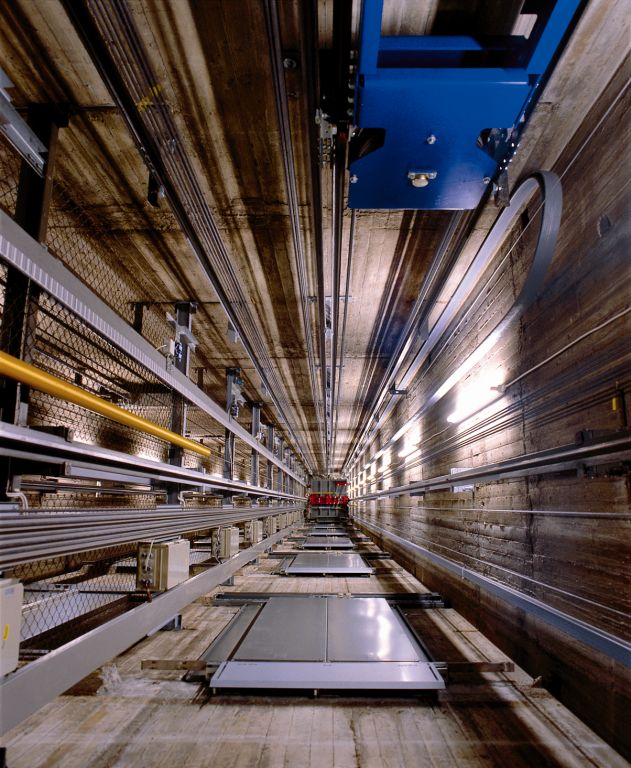 For new installations in small to medium-sized buildings, MRL elevators eliminate the usually large elevator rooms, replacing them with a compact machine tucked into the top of the elevator shaft. "With this innovation, KONE managed to create a technology which changed the whole industry. At the time, no one could have expected how successful it would become. Now, 10 years later, there are no doubts about its success," said Heikki Leppänen, executive vice president and director for new equipment at KONE. Prior describes an MRL elevator as such: “An MRL type elevator is a system that utilizes a geared or gearless hoist machine. All or some of the other major elevator components (controller, drive, isolation, etc.) with an MRL application may or may not be located in the elevator hoistway, depending on the application and local codes.”
For new installations in small to medium-sized buildings, MRL elevators eliminate the usually large elevator rooms, replacing them with a compact machine tucked into the top of the elevator shaft. "With this innovation, KONE managed to create a technology which changed the whole industry. At the time, no one could have expected how successful it would become. Now, 10 years later, there are no doubts about its success," said Heikki Leppänen, executive vice president and director for new equipment at KONE. Prior describes an MRL elevator as such: “An MRL type elevator is a system that utilizes a geared or gearless hoist machine. All or some of the other major elevator components (controller, drive, isolation, etc.) with an MRL application may or may not be located in the elevator hoistway, depending on the application and local codes.”
"With its multiple advantages, the MRL concept offers a win-win situation for all parties," Leppänen continued. An MRL mechanically lifts without the need for lubricant oils. Reportedly, it also consumes only 60% of the electricity of other geared traction machines. The elimination of the elevator room reduces the building’s square footage (usually 300-500 square feet), which saves on extra building materials and, over time, utility costs. Furthermore, the gearless design provides a smoother, quieter ride for its passengers.
Since KONE introduced the MRL elevator, they have estimated how much energy has been conserved since the first MRL was installed. “Since 1998, the KONE MonoSpace® elevator family has cumulatively saved the equivalent electricity production of a typical power plant (250 MW), avoiding the consumption of 2,000,000 barrels of oil, and the CO2 emissions of 100,000 cars driving the distance of earth’s 40,074km circumference,” said Oijala. The market indeed is now full of MRL options, such as: KONE provides the MonoSpace® and the MiniSpace™; Otis provides the Gen2®; ThyssenKrupp provides synergy; Schindler provides the SMART MRL™; and Fujitec provides the Millennium II. “It is estimated that by the end of 2010, two-thirds of the world's new elevators will feature MRL technology, further proof that the MRL concept is as valuable today as it was when it was launched over a decade ago,” said Oijala.
Destination Control Software
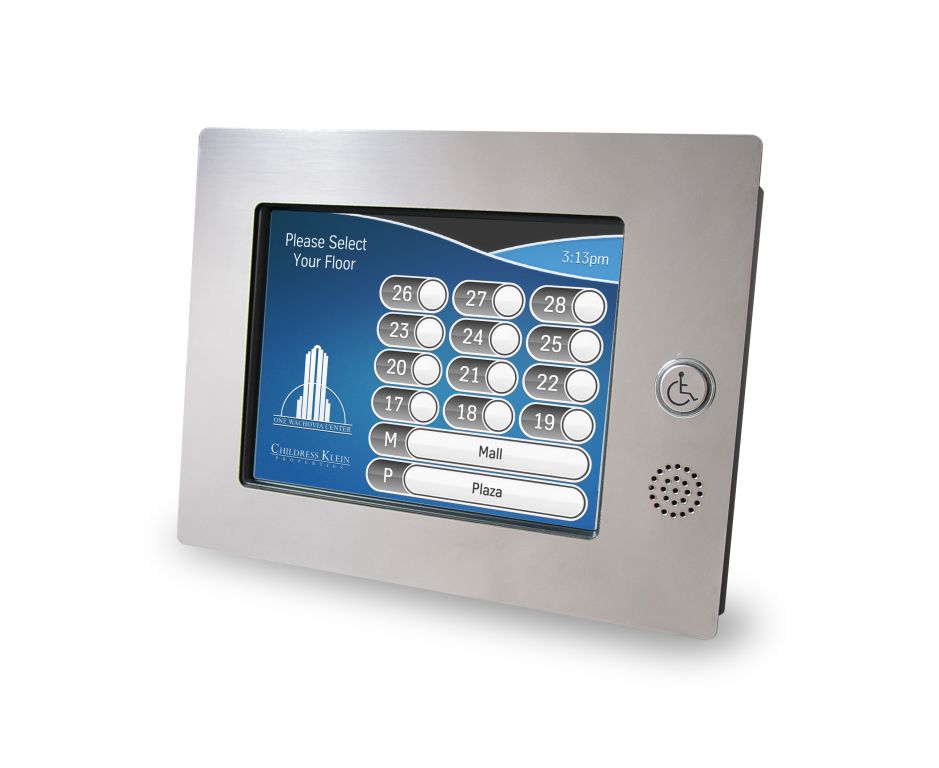 Most applicable for the skyscraper is the invention of destination control software. When introduced by Schindler Elevator Corp., the ability for passengers to travel efficiently greatly increased. Since there are multiple floors in a skyscraper, the destination control software organizes groups of passengers. For example, rather than stopping at multiple floors for various individuals, the destination dispatch system groups all passengers traveling to a specific floor in one trip.1 As a group approaches the bay of elevators, each passenger enters their destination information via a company ID badge, a key code, or another similar device. Subsequently, the passengers are gathered together and assigned to elevator cabs. The convenience of this system is beneficial; increasingly, the elimination of wasted energy is a positive environmental improvement. The software drastically reduces user wait-time and increases handling capacity by up to thirty percent. Environmental benefits are abundant, as well, decreasing the amount of wasted energy expense by maximizing elevator efficiency through passenger destination selection.1
Most applicable for the skyscraper is the invention of destination control software. When introduced by Schindler Elevator Corp., the ability for passengers to travel efficiently greatly increased. Since there are multiple floors in a skyscraper, the destination control software organizes groups of passengers. For example, rather than stopping at multiple floors for various individuals, the destination dispatch system groups all passengers traveling to a specific floor in one trip.1 As a group approaches the bay of elevators, each passenger enters their destination information via a company ID badge, a key code, or another similar device. Subsequently, the passengers are gathered together and assigned to elevator cabs. The convenience of this system is beneficial; increasingly, the elimination of wasted energy is a positive environmental improvement. The software drastically reduces user wait-time and increases handling capacity by up to thirty percent. Environmental benefits are abundant, as well, decreasing the amount of wasted energy expense by maximizing elevator efficiency through passenger destination selection.1
Eco-Friendly Retrofitting Options
When modernizing, Stuart Prior of ThyssenKrupp describes a few green strategies such as: replacing existing incandescent lighting fixtures with LEDs, installing a light sensor that turns off the cabinet lights when not in use, updating to a microprocessor-based controller, switching out DC controllers with AC controllers, and using light to clear oils rather than petroleum-based fluids for hydraulic machines. “There are approximately 900,000 elevators in use in North America and many of them are 40-50 years old. Today, the modernization business is as large a market as new construction,” said Prior. Furthermore, modernizing an elevator with a new type of green technology, like those suggested by Prior, may garnish extra Innovative Points in the LEED Existing Building (EB) registration system.
Replacing all the incandescent light fixtures with LED lamps is one of the simplest green renovation strategies. LEDs use only 4% of the amount of energy used by incandescent bulbs. Not only the overhead cab lighting, but even the buttons and the floor lights can be replaced as well. Particularly when installed as the overhead cab lighting, LEDs produce less heat, so the cooling load is reduced and more environmental savings are increased.
Currently, many aged traction units have DC units. They are less energy-efficient compared to AC units, which minimize heat production, reducing overall energy expenditure.1 Therefore, installing a new AC controller to replace a DC controller is yet another straightforward way to increase the energy efficiency of the elevator system. The up-front cost of the AC drive control is greater than keeping DC drive, but the overall savings for the technology and electrical usage can be significant. Microprocessor-based controllers are the most energy efficient choice.1
Seasoned hoisting and hydraulic elevators that use hazardous lubricants can also function with more environmentally friendly clear to lightly colored lubricants, such as: mineral, vegetable and non-petroleum based synthetic oils. The motivation behind replacing petroleum based oils for the elevator is to ensure that lubricants do not accidentally leach into the ground water supply. Though rare, there are reported cases throughout the U.S. where an elevator started to leak petroleum-based oils into the ground surrounding the building. For this reason, most building maintenance programs factor in a yearly inspection of the elevator system to trouble-shoot an environmental pollution spill. If the “black” lubricants are not properly contained and disposed, this type of pollution to the ground water table may become severe.
Sustainable Finish Materials
Specifying and replacing interior finishes for the elevator cab with low Volatile Organic Compounds (VOCs) and other sustainable interior finishes will improve the indoor air quality. Certain plastics that off-gas (a term to describe when chemicals are released into the atmosphere via evaporation) can, within a few months after installation, contribute to a harmful breathing atmosphere. Therefore, special care should be taken to install finish materials that will not off-gas. At the very least, a full two week building ventilation flush-out can lessen the impact of the off-gassing. It is also best to specify and install low-VOC coatings, sealants and adhesives to insure excellent indoor air quality. Many VOC pollutants are carcinogenic; they often contribute to allergic reactions, and, most commonly, give occupants headaches and migraines. A few other sustainable material possibilities are derived from rapidly-renewable resources and recycled products, such as: bamboo flooring, linoleum (made from linseed oil) rather than VCT, recycled and C2C carpets and wall coverings.
New York City is an example of a vertical metropolis that conserves natural resources simply by building with small geographical footprints. Bruce S. Fowle, who practices architecture in New York City, designed the first recognized green skyscraper in the U.S. As an active member of the USGBC and of various LEED programs, Fowle lauds the elevator as one of the most phenomenal building tools yet invented for green construction. “I would agree with Bruce S. Fowle. To reduce the core space and to move people faster through the building are two very important factors in making a building green,” concluded Stuart Prior of ThyssenKrupp. When newly installed, elevators are green in their application for tall buildings, with new technologies that: reduce energy, consume less programmable space, and avoid the potential for environmental pollution. For revitalization projects, green strategies help to keep the indoor air quality high and the electric bill low.
See also: Mitigating Elevator Noise in Multifamily Residential Buildings
Smoke Migration in Elevator Shafts
Cited Work
- BOMA Magazine. Protecting the Environment and Your Money: How Elevators are Going Green. 09 April 2008.
References
- Otis Elevator Co., Inc. 21 May 2008.
- Comparison of LED versus Incandescent Light Bulbs. 21 May 2008. http://hollysolar.com/archive/Comparison.pdf
- IEEE Xplore. Justification for AC versus DC drives. 21 May 2008.
- KONE. Green Elevator Product Assists in Energy-saving for New Generation Houses for 21st Century. 08 November 2006. http://www.kone.no/en_CN/main/0,,content=60596,00.html
- KONE. KONE at the 5th China International Exhibition of Elevator Equipment and Technology in Beijing. 19 April 2002 http://www.kone.com/en_C/main/0,,content=17031,00.html
- ThyssenKrupp Elevator. Machine Room-Less. 09 April 2008.
- Otis. Gen2 Elevator. 09 April 2008. http://www.otis.com/products/detail/0,1355,CLI1_PRD16916_PRT30_PST708_RES1.00.html
- The Museum for the Preservation of Elevating History. Timeline. 09 April 2008.

Stephanie Aurora Lewis
Stephanie, an NCARB registered architect and LEED AP, draws upon her studies in architectural history and theory from Sarah Lawrence College and her master’s degree in architecture from The Ohio State University. Providing copy for publications and performing marketing work for the construction industry, Stephanie works as an independent freelancer from Columbus, Ohio.
Website: greengaloredesigner.blogspot.com/
